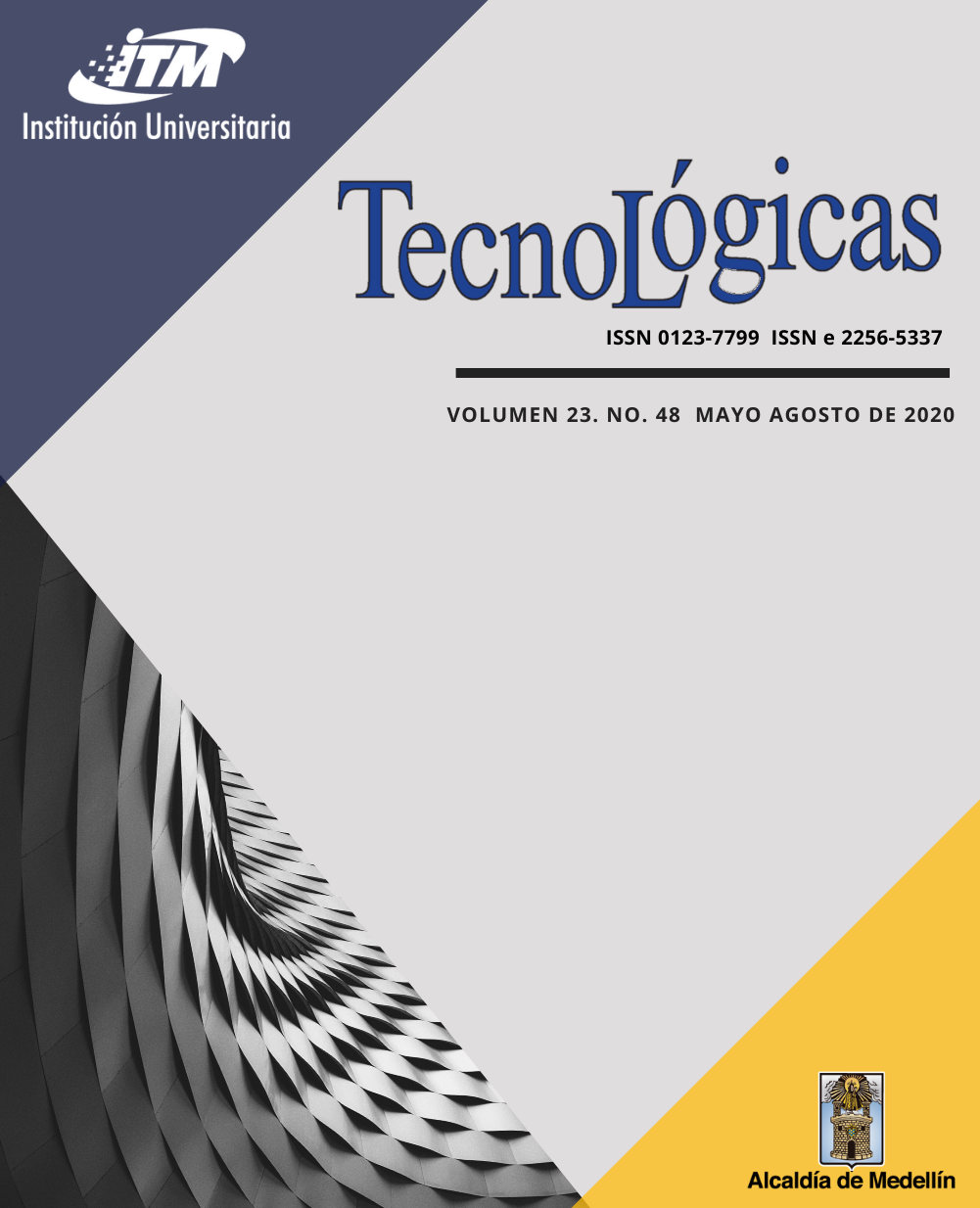Segmentación multi-modal de imágenes RGB-D a partir de mapas de apariencia y de profundidad geométrica
Resumen
Los algoritmos clásicos de segmentación de imágenes explotan la detección de similitudes y discontinuidades en diferentes señales visuales, para definir regiones de interés en imágenes. Sin embargo, debido a la alta variabilidad e incertidumbre en los datos de imagen, se dificulta generar resultados acertados. En otras palabras, la segmentación basada solo en color a menudo no es suficiente para un gran porcentaje de escenas reales. Este trabajo presenta una nueva estrategia de segmentación multi-modal que integra señales de profundidad y apariencia desde imágenes RGB-D, por medio de una representación jerárquica basada en regiones, es decir, un árbol de segmentación multi-modal (MM-tree). Para ello, la imagen RGB-D es descrita de manera complementaria por diferentes mapas de segmentación. A partir de la imagen de color, se implementa un árbol de segmentación de color (C-tree) para obtener mapas de segmentación y sobre-segmentación. Desde de la imagen de profundidad, se derivan dos mapas de segmentación independientes, los cuales se basan en el cálculo de primitivas de planos y de bordes 3D. Seguidamente, un proceso de fusión jerárquico de regiones permite agrupar de manera local los mapas obtenidos anteriormente en el MM-tree. Por último, el nivel superior emergente del MM-tree integra coherentemente la información disponible en los mapas de profundidad y apariencia. Los experimentos se realizaron con el conjunto de imágenes RGB-D del NYU-Depth V2, evidenciando resultados competitivos, con respecto a los métodos de segmentación del estado del arte. Específicamente, en las imágenes de prueba, se obtuvieron puntajes promedio de 0.56 en la medida de Segmentation Covering y 2.13 en Variation of Information.
Referencias bibliográficas
P. Arbelaez, M. Maire, C. Fowlkes, and J. Malik, “Contour Detection and Hierarchical Image Segmentation,” IEEE Trans. Pattern Anal. Mach. Intell., vol. 33, no. 5, pp. 898–916, May. 2011. https://doi.org/10.1109/TPAMI.2010.161
X. Wang, Y. Tang, S. Masnou, and L. Chen, “A Global/Local Affinity Graph for Image Segmentation,” IEEE Trans. Image Process., vol. 24, no. 4, pp. 1399–1411, Apr. 2015. https://doi.org/10.1109/TIP.2015.2397313
J. Han, L. Shao, D. Xu, and J. Shotton, “Enhanced Computer Vision With Microsoft Kinect Sensor: A Review,” IEEE Trans. Cybern., vol. 43, no. 5, pp. 1318–1334, Oct. 2013. https://doi.org/10.1109/TCYB.2013.2265378
N. Silberman, D. Hoiem, P. Kohli, and R. Fergus, “Indoor segmentation and support inference from RGBD images,” Comput. Vis. -- ECCV 2012 12th Eur. Conf. Comput. Vis., pp. 746–760, Berlin, 2012. https://doi.org/10.1007/978-3-642-33715-4_54
X. Ren, L. Bo, and D. Fox, “RGB-(D) scene labeling: Features and algorithms,” in 2012 IEEE Conference on Computer Vision and Pattern Recognition, Providence, 2012, pp. 2759–2766. https://doi.org/10.1109/CVPR.2012.6247999
S. Gupta, P. Arbelaez, and J. Malik, “Perceptual organization and recognition of indoor scenes from RGB-D images,” in Proceedings of the IEEE Conference on Computer Vision and Pattern Recognition, Portland, 2013, pp. 564–571. https://doi.org/10.1109/CVPR.2013.79
Z. Li, X. M. Wu, and S. F. Chang, “Segmentation using superpixels: A bipartite graph partitioning approach,” in 2012 IEEE Conference on Computer Vision and Pattern Recognition, Providence, 2012, pp. 789–796. https://doi.org/10.1109/CVPR.2012.6247750
R. Nock and F. Nielsen, “Statistical region merging,” IEEE Trans. Pattern Anal. Mach. Intell., vol. 26, no. 11, pp. 1452–1458, Nov. 2004. https://doi.org/10.1109/TPAMI.2004.110
J. Yang, Z. Gan, K. Li, and C. Hou, “Graph-Based Segmentation for RGB-D Data Using 3-D Geometry Enhanced Superpixels,” IEEE Trans. Cybern., vol. 45, no. 5, pp. 927–940, May 2015. https://doi.org/10.1109/TCYB.2014.2340032
A. Richtsfeld, T. Mörwald, J. Prankl, M. Zillich, and M. Vincze, “Learning of perceptual grouping for object segmentation on RGB-D data,” J. Vis. Commun. Image Represent., vol. 25, no. 1, pp. 64–73, Jan. 2014. https://doi.org/10.1016/j.jvcir.2013.04.006
L. Cruz, D. Lucio, and L. Velho, “Kinect and rgbd images: Challenges and applications,” in Graphics, Patterns and Images Tutorials (SIBGRAPI-T), 2012 25th SIBGRAPI Conference on, Ouro Preto, 2012, pp. 36–49. https://doi.org/10.1109/SIBGRAPI-T.2012.13
K. Chen, Y.-K. Lai, and S.-M. Hu, “3D indoor scene modeling from RGB-D data: a survey,” Comput. Vis. Media, vol. 1, no. 4, pp. 267–278, Dec. 2015. https://doi.org/10.1007/s41095-015-0029-x
D. Lin, G. Chen, D. Cohen-Or, P. A. Heng, and H. Huang, “Cascaded Feature Network for Semantic Segmentation of RGB-D Images,” in 2017 IEEE International Conference on Computer Vision (ICCV), Venice, 2017, pp. 1320–1328. https://doi.org/10.1109/ICCV.2017.147
J. McCormac, A. Handa, S. Leutenegger, and A. J. Davison, “SceneNet RGB-D: Can 5M Synthetic Images Beat Generic ImageNet Pre-training on Indoor Segmentation?,” in 2017 IEEE International Conference on Computer Vision (ICCV), Venice, 2017, pp. 2697–2706. https://doi.org/10.1109/ICCV.2017.292
W. Wang and U. Neumann, “Depth-aware cnn for rgb-d segmentation,” in Proceedings of the European Conference on Computer Vision (ECCV), Switzerland, 2018, pp. 135–150. https://doi.org/10.1007/978-3-030-01252-6_9
Y. Guo, Y. Liu, T. Georgiou, and M. S. Lew, “A review of semantic segmentation using deep neural networks,” Int. J. Multimed. Inf. Retr., vol. 7, no. 2, pp. 87–93, Jun. 2018. https://doi.org/10.1007/s13735-017-0141-z
D. Huang, J.-H. Lai, C.-D. Wang, and P. C. Yuen, “Ensembling over-segmentations: From weak evidence to strong segmentation,” Neurocomputing, vol. 207, pp. 416–427, Sep. 2016. https://doi.org/10.1016/j.neucom.2016.05.028
J. Smisek, M. Jancosek, and T. Pajdla, “3D with Kinect,” in Consumer depth cameras for computer vision, London: Springer, 2013, pp. 3–25. https://doi.org/10.1007/978-1-4471-4640-7_1
M. Maire, P. Arbelaez, C. Fowlkes, and J. Malik, “Using contours to detect and localize junctions in natural images,” in 2008 IEEE Conference on Computer Vision and Pattern Recognition, Anchorage, Ak, 2008, pp. 1–8. https://doi.org/10.1109/CVPR.2008.4587420
P. Arbelaez, “Boundary extraction in natural images using ultrametric contour maps,” in Computer Vision and Pattern Recognition Workshop, 2006. CVPRW’06. Conference on, New York, 2006, pp. 182. https://doi.org/10.1109/CVPRW.2006.48
C. Feng, Y. Taguchi, and V. R. Kamat, “Fast plane extraction in organized point clouds using agglomerative hierarchical clustering,” in 2014 IEEE International Conference on Robotics and Automation (ICRA), Hong Kong, 2014, pp. 6218–6225. https://doi.org/10.1109/ICRA.2014.6907776
R. Hulik, M. Spanel, P. Smrz, and Z. Materna, “Continuous plane detection in point-cloud data based on 3D Hough Transform,” J. Vis. Commun. Image Represent., vol. 25, no. 1, pp. 86–97, Jan. 2014. https://doi.org/10.1016/j.jvcir.2013.04.001
T. H. Kim and K. M. Lee, S. U. Lee, “Learning full pairwise affinities for spectral segmentation,” in 2010 IEEE Computer Society Conference on Computer Vision and Pattern Recognition, Jul. 2013, pp. 1690-1703. https://doi.org/10.1109/TPAMI.2012.237
P. Arbelaez, M. Maire, C. Fowlkes, and J. Malik, “From contours to regions: An empirical evaluation,” in 2009 IEEE Conference on Computer Vision and Pattern Recognition, Miami, 2009, pp. 2294–2301. https://doi.org/10.1109/CVPR.2009.5206707
R. Unnikrishnan, C. Pantofaru, and M. Hebert, “Toward Objective Evaluation of Image Segmentation Algorithms,” IEEE Trans. Pattern Anal. Mach. Intell., vol. 29, no. 6, pp. 929–944, Jun. 2007. https://doi.org/10.1109/TPAMI.2007.1046
M. Meilǎ, “Comparing clusterings: an axiomatic view,” in Proceedings of the 22nd international conference on Machine learning, Aug. 2005, pp. 577–584. https://doi.org/10.1145/1102351.1102424
A. Goder and V. Filkov, “Consensus clustering algorithms: Comparison and refinement,” in Proceedings of the Meeting on Algorithm Engineering & Expermiments, Jan. 2008, pp. 109–117. http://dl.acm.org/citation.cfm?id=2791204.2791215
Descargas
| Estadísticas de artículo | |
|---|---|
| Vistas de resúmenes | |
| Vistas de PDF | |
| Descargas de PDF | |
| Vistas de HTML | |
| Otras vistas | |









